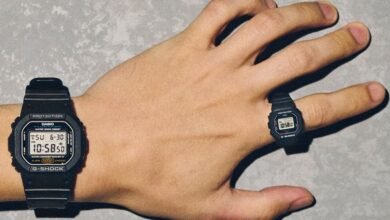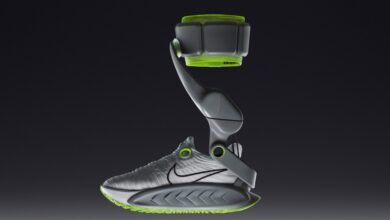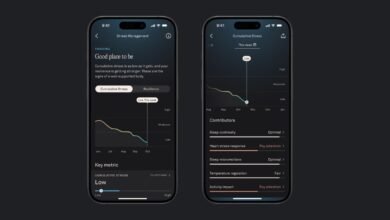
▼ Summary
– Fitbit remains a recognizable brand offering affordable trackers for general activity and health monitoring, though not aimed at hardcore athletes.
– The Google Pixel Watch 3 is a significant upgrade with improved design, fitness features, and integration with Google services and AI.
– Fitbit’s Charge 6 is a high-value fitness band with advanced sensors like EKG and built-in GPS, competing with more expensive smartwatches.
– The Fitbit Ace LTE is a kid-focused smartwatch that tracks active minutes and offers family communication features through a subscription.
– Google continues to invest in Fitbit with upcoming AI-powered health coaching and hardware improvements like the Pixel Watch 4.
Finding the right fitness tracker can feel overwhelming, but Fitbit remains a strong contender for those seeking reliable activity monitoring without the complexity of advanced smartwatches. Even after Google’s acquisition, the brand continues offering devices that balance essential health metrics with user-friendly designs. While serious athletes might prefer specialized gear, Fitbit delivers excellent value for everyday wellness tracking, including features like EKG readings and blood oxygen monitoring.
Our evaluation process involves extensive real-world testing across various scenarios. We wear these devices during sleep, exercise sessions, and daily activities to assess their performance. Key considerations include battery longevity, accuracy of health metrics, compatibility with smartphones, and overall durability. For children’s models, we involve young testers to gather authentic feedback about usability and appeal.
Battery performance stands out as a major advantage for Fitbit devices. Most models promise approximately five days of use between charges, though enabling features like always-on displays significantly reduces this duration. Understanding realistic battery expectations helps determine which model suits your lifestyle.
When examining feature sets, you’ll notice core functions like step counting and notifications appear across most devices. However, advanced capabilities such as EKG monitoring, stress tracking, and built-in GPS vary by model. The critical question becomes whether the included features justify the price point and whether any essential functions are missing.
Pricing strategy has always been part of Fitbit’s appeal, positioning these devices as affordable alternatives to premium smartwatches. Still, the wearable market has evolved dramatically, making value assessment more important than ever.
Considering intended users involves evaluating design versatility and durability. A device meant for casual wear should transition seamlessly from workouts to professional settings, while trackers designed for active users or children require robust construction.
Despite Google’s increasing integration with the brand, several reasons make Fitbit trackers worth considering. They frequently appear in sales events, making them budget-friendly options. Every purchase includes a complimentary Fitbit Premium trial, providing guided workouts, meditation content, and detailed health analytics. This subscription normally costs $9.99 monthly or $79.88 annually. Google’s commitment to wearables remains evident with the Pixel Watch 4 launch, featuring extended battery life, improved repairability, and integration with Fitbit’s upcoming AI fitness coach.
For those open to alternatives beyond the Fitbit ecosystem, numerous other fitness trackers and smartwatches deliver comparable functionality.
Premium Smartwatch Experience
The Pixel Watch 3 represents Google’s refined vision for wearable technology. While technically a Google product, it leverages Fitbit’s health tracking expertise, creating what might be the ideal smartwatch Fitbit never developed independently.
This third-generation model demonstrates significant improvements over earlier versions. The display appears brighter, bezels have shrunk, and a new 45mm size accommodates larger wrists without appearing bulky. Internally, health sensors match those in the Pixel Watch 2, but the addition of ultra wideband technology enables unlocking compatible Pixel phones and select BMW vehicles.
Its elegant circular domed display surpasses the angular aesthetics of previous Versa or Sense models. The device genuinely resembles a sophisticated timepiece rather than an obvious activity tracker. While the screen’s durability concerns some users, extended warranty options through Preferred Care provide peace of thumb in the US and Canada. Google now offers discounted replacement programs for out-of-warranty devices, simplifying repair processes.
Fitness capabilities have notably improved for runners. The running dashboard now includes advanced form analysis, customized workouts, and AI-generated exercise suggestions. A new Cardio Load metric measures workout intensity and establishes targets aligned with fitness objectives, similar to Garmin’s Training Load system. The redesigned Daily Readiness Score no longer requires Premium subscription, and the innovative Loss of Pulse feature automatically contacts emergency services if it detects cardiac arrest.
Integration with Google’s ecosystem has strengthened considerably. Offline Google Maps, Google Home controls, Nest camera viewing, and Google TV management all operate directly from your wrist. The Recorder app transfers audio to your phone, while Call Assist notifies callers you need moment before answering.
Google Gemini integration enables complex tasks like restaurant recommendations, calendar management, playlist creation, and email summarization. Though not flawless, this AI assistant generally proves helpful. Channel Sounding technology enhances Bluetooth tracking precision by measuring signal travel time between the watch and compatible accessories.
Patient shoppers might consider waiting for the Pixel Watch 4 launching October 9th at $349.99. This upcoming model promises upgraded processing power, faster charging, extended battery life, redesigned aesthetics, and improved repairability. It becomes the first Pixel Watch with replaceable displays and batteries rather than requiring full device replacement. The LTE variant includes free Satellite SOS functionality for emergency communication without cellular service.
The $199.95 Versa 4 represents a budget-friendly alternative for those wanting smartwatch aesthetics with fitness tracking capabilities. The Sense 2 has become largely redundant since the Pixel Watch 3 outperforms it across all metrics.
Budget-Conscious Choice
The Inspire series has evolved considerably, with the $99.95 Inspire 3 emerging as an excellent entry-level option. Its color OLED display recalls the 2021 Fitbit Luxe, though with a matte black plastic casing instead of metal construction. This device appeals strongly to users seeking straightforward activity tracking without unnecessary complexity.
The Inspire 3 focuses on essential functions, omitting built-in GPS, contactless payments, and digital assistants. Instead, it delivers Fitbit’s sophisticated sleep analysis, stress management tools, and irregular heart rate alerts. The vibrant OLED screen represents a substantial upgrade from the Inspire 2’s monochrome display, while maintaining approximately 10-day battery life (reduced to two or three days with always-on display enabled).
Various accessories enhance its versatility, including discreet clip attachments and elegant mesh straps in gold or silver finishes.
While similar to the Luxe model, the Inspire 3 offers five additional days of battery life and remains readily available, whereas the Luxe has become increasingly difficult to find through official retailers.
Advanced Fitness Band
The Charge series maintains its popularity, with the $159.95 Charge 6 representing Fitbit’s premium fitness band. It competes effectively with the more expensive Versa 4, featuring a color OLED screen, EKG and EDA sensors, built-in GPS, NFC payments, and SpO2 monitoring. Only digital assistant functionality is absent.
Our primary concern involves the always-on display’s impact on battery performance. While the Charge 6 promises seven days of operation, this diminishes to approximately two days with the display constantly active. This limitation mirrors our experience with the Charge 5, though it has become common across Fitbit’s current lineup.
Overall, the value proposition remains impressive. It’s the only FDA-cleared EKG wearable available under $200, with only the Sense models and Pixel Watch 3 offering similar EKG and EDA capabilities. Unless you specifically prefer the smartwatch form factor, the Charge 6 delivers superior value.
Compared to its predecessor, the Charge 6 incorporates enhanced heart rate algorithms, Bluetooth connectivity with certain gym equipment, and additional apps including Google Maps, Google Wallet, and YouTube Music. The YouTube Music integration functions well though requires a separate $10.99 monthly subscription, which remains preferable to Fitbit’s discontinued onboard music storage.
Hardware improvements include replacing the inductive groove with a more reliable haptic button. While not a physical button, this implementation has proven more consistent in daily use.
Family-Friendly Option
The $179.99 Fitbit Ace LTE diverges from traditional fitness tracking, functioning instead as a communication-focused smartwatch with kid-appropriate games and activities. It creates a protected digital environment with thoughtful family communication features.
Rather than detailed health statistics, the Ace LTE monitors “active minutes” that fill a charming progress meter called a Noodle encircling the watch face. These minutes unlock gaming time and activities that customize your child’s avatar (Eejie) and its virtual home. Different watch straps unlock additional games and virtual items.
A $10 monthly subscription enables real-time location tracking plus voice and text messaging to pre-approved contacts through the dedicated Fitbit Ace app. Since November 2024, this includes communication between family members wearing Ace LTE watches and group chats connecting parents and children.
The Ace LTE’s construction resembles adult smartwatches more than typical children’s devices like the plastic Garmin Bounce. It shares charging compatibility with the Pixel Watch 3 and delivers approximately one day of battery per charge. Children enjoy the device without becoming overly dependent, though they sometimes engage in extra activity to earn additional gaming time.
Google recommends the Ace LTE for children aged 7 to 11, which aligns with our testing experience. Our 10-year-old tester has used the device for approximately one year successfully, though middle school students might find the communication limitations frustrating. Our 8-year-old tester appreciates texting capabilities with their sibling, despite occasional emoji spam in family group chats.
Future Developments
Google recently announced the Fitbit personal health coach, an AI-powered fitness trainer utilizing Gemini technology. This feature begins rolling out in October to Fitbit Premium subscribers using latest-generation Fitbit trackers, Fitbit smartwatches, and Pixel Watch models through a redesigned Fitbit application.
The AI health coach develops weekly exercise regimens adaptable to sleep patterns, existing injuries, and evolving fitness objectives. During recent demonstrations, we observed impressive flexibility accommodating life circumstances. A 14-hour flight with jet lag won’t derail cardio goals since they calculate weekly rather than daily. Mentioning a finger injury prompts the system to recommend alternative exercises excluding strength training.
Current Considerations
Early 2025 brought a mandatory software update for Fitbit Versa 3 and Sense devices addressing potential battery overheating, though some users reported reduced battery life from six days to just one. However, the forthcoming redesigned Fitbit app and AI health coach demonstrate Google’s ongoing investment in the Fitbit ecosystem. Hardware enhancements in the Pixel Watch 4 further indicate Google’s commitment to developing compelling wearable technology.
(Source: The Verge)





